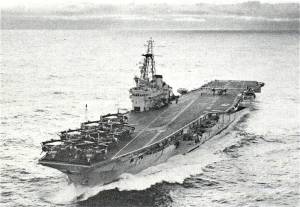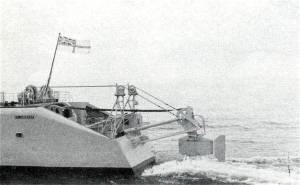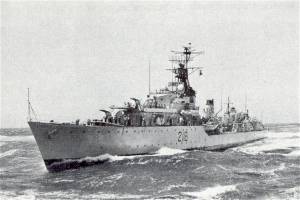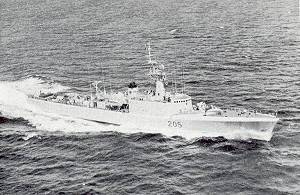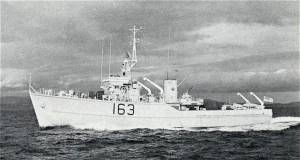The
1960s
The State of the RCN in 1963
Part 4: The RCN Today
|
|
Presentation given to the House of Commons on July 9th, 1963 by Vide-Admiral H.S. Rayner, Chief of Naval Staff.
To meet the role and to carry out the tasks that I have listed, the RCN consists of one A/S aircraft carrier, 43 anti-submarine escorts, 10 minesweepers and a variety of support and auxiliary craft. These ships are based as follows:
On the East Coast we have:
1 aircraft carrier with a squadron of Tracker aircraft and a squadron of helicopters embarked
11 destroyer escorts of the St. Laurent, Restigouche and Mackenzie classes
8 Tribal class destroyer escorts
10 frigates
6 minesweepers
3 Royal Navy submarines on loan
1 fleet replenishment ship
1 maintenance repair ship
3 squadrons of aircraft shore-based at the Naval Air Station, Dartmouth
On the West Coast we have
7 destroyer escorts of the St. Laurent and Mackenzie classes
7 frigates
4 minesweepers
1 submarine
1 maintenance repair ship
1 squadron of aircraft shore-based at Patricia Bay.
I would like to show you these various types of ships and aircraft by classes.
First, the aircraft carrier, HMCS Bonaventure, a 20,000-ton ship, was commissioned in Belfast in 1957 and carries up to 18 CS2F or Tracker aircraft and up to six helicopters. Both types of aircraft are used
Figure
1: HMCS BONAVENTURE. (BN-3307) (Click image for a larger version) |
You will recall that last September while the Bonaventure was on passage to European waters for a NATO exercise she played an important part in an air-sea rescue incident, when an American plane loaded with U.S. servicemen and their dependents went down in the Atlantic off Ireland.
Next we turn to the escorts. These can be divided into three main categories: the older type destroyers of Second World War vintage, such as the Tribal class; then the new types, the St. Laurent, Restigouche and Mackenzie class destroyer escorts, and lastly the frigates, smaller and slower, which, once again, are older wartime-built ships.
|
Figure
2: Variable Depth Sonar installation in HMCS ST. LAURENT.
(E-65750)
(Click image for a larger version) |
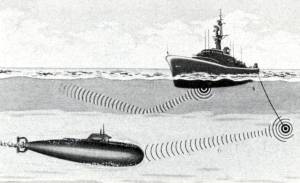 |
|
Figure
3: How variable depth sonar works. (CN-6031)
(Click image for a larger version) |
But, first, before showing you photographs of the escorts I would like to give you a brief explanation of the anti-submarine equipment and weapons used by ships.
The
device used by ships for detecting, and tracking submarines up to
the moment of attack is sonar, which is an abbreviation of the phrase
“sound navigation and ranging”. Sound waves from a transmitter
in the bottom of the ship travel out in ever widening circles. When
these waves strike an object such as a submarine an “echo”
travels back to a receiver in the ship. Electronic devices compute
the bearing and range of the object and display and record this
information in the ship. A fire control computer calculates when
the anti-submarine weapons should be fired and fires them.
Figures
2 and 3 show the variable depth sonar, or VDS, a Canadian development.
With this device the sonar transmitter and receiver can be suspended
hundreds of feet below the ship on a cable, well away from surface
noises. The depth selected is that below the area where sudden temperature
changes occur in the water and produce a “temperature layer”,
which bends and distorts the sound waves in the same way that a
prism bends light waves.
The submarine can be attacked with one of two ship-borne weapons:
a pattern of depth bombs, or with a torpedo which homes onto or
seeks out the submarine.
|
Figure
4: HMCS CAYUGA, Tribal class destroyer escort. (OT-3357)
(Click image for a larger version) |
Figure 4 shows a Tribal class destroyer. There are 11 ships of this type which were built during and shortly after the Second World War. They are equipped with guns for use against surface and air targets and also shore bombardment. They also have good antisubmarine equipment and weapons. Thus they are versatile ships with a good general purpose capability. But, after distinguished service, they are rapidly wearing out and should be phased out completely by 1970.
Next
we have the St. Laurent class destroyer escort. These ships entered
service in 1955 and there are seven of them. This was the first
Canadian-designed A/S ship.
In recent months there has been quite a lot of public speculation about the capability of our modern destroyer escorts, the St. Laurents and their successors. The sailors nicknamed these ships “Cadillacs” when they first joined the Fleet, not only because of their cost but because they were the best and latest of their kind.
What
is their potential today? Are they up to date? This is important
because these ships, the St. Laurents and their successors, the
Restigouches and the Mackenzies, will form the backbone of our A/S
surface forces for several years ahead.
The seven St. Laurents were designed in 1949 and completed from 1955 onwards. The seven Restigouches and six Mackenzies, which followed, were both designed in 1956 but the basic design was the St. Laurent. The Restigouches were completed between 1958 and 1960 and the Mackenzies, which are essentially repeat Restigouches, are just being completed now. Three Mackenzies have been commissioned and the class will be completed in 1964. The last two Mackenzies will be a great advance on the 18 earlier ships for reasons which I will come to.
|
Figure
5: HMCS ST. LAURENT, before conversion.
(Click image for a larger version) |
These 20 ships are all highly specialized anti-submarine vessels. They were designed to destroy the modern conventional submarine. As you might expect they are a great advance on anything we had in the Second World War, but so is the modern, conventional submarine.
But the really significant advance in naval warfare was the advent of the nuclear submarine Nautilus in 1957, to be followed by the Polaris submarines in 1960. These events changed matters almost overnight. Instead of having to deal with submarines with fairly high submerged speeds, but very limited endurance underwater, navies are now faced with the problem of hunting submarines, with very high submerged speeds, greater diving depth and sustained underwater endurance. In fact, as far as the nuclear submarine herself is concerned, she can stay under water for months on end. Fortunately for us, at the present time there are comparatively few of these boats at sea, but many more will undoubtedly come.
One of the most urgent military problems confronting the West—and for that matter the East also—is the problem of defence against the nuclear submarine armed with long-range missiles—or indeed against any nuclear submarine.
Our present destroyer escorts have a very limited capability against nuclear submarines, but they are first-class against conventional submarines which, as you have heard, constitute the vast majority of submarines in the Russian fleet today.
However, what are we doing about defence against the nuclear submarine?
Much
research and development has been done and continues. Although the
problem is a long way from being solved, there are promising developments
and some good hardware has been produced. In Canada we have developed
variable depth sonar which provides more reliable detection at increased
ranges. This device is being fitted in the last two Mackenzies,
which
I mentioned earlier. The seven St. Laurent escorts are also being
converted to carry variable depth sonar.
At the same time as they are being equipped with variable depth sonar, our destroyer escorts are being given landing platforms, and the facilities for operating helicopters, which will carry both sonar and weapons. This is an important Canadian concept, the idea of operating a large, all-weather, A/S helicopter, equipped with both sonar and weapons from a destroyer escort. The Sikorsky HSS-2s are on order and the first was accepted for trials in May. These helicopters will be much faster than nuclear submarines. This destroyer escort helicopter combination will normally work as a unit.
|
Figure
6: Artist's conception of converted St. Laurent class destroyer
escort, with helicopter platform, hangar and variable depth
sonar. (CN-6407)
(Click image for a larger version) |
Figure 6 is an artist’s impression of a converted St. Laurent. The first ship of this class to be converted is the Assiniboine who will complete her conversion this month and will commence helicopter trials in October on the East Coast. These will be extensive trials lasting at least six months. She will be joined by the converted St. Laurent herself in early 1964. It is planned to complete the conversion of seven St. Laurents by the end of 1965.
|
Figure
7: HMCS BEACON HILL, Prestonian class frigate. (E-43508)
(Click image for a larger version) |
Finally, we have (Figure 7) the slowest of the escorts, the Prestonian class frigates. There are 17 of them. They are smaller than the destroyer escorts and much less complex. They have an ASW capability against conventional submarines and a twin four-inch gun which gives them a surface-to-surface capability. Like the Tribals these ships are rapidly reaching the end of their economical lives.
The RCN also has in commission 10 Canadian-built coastal minesweepers (Figure 8).
The life expectancy of these ships when certain improvements have been made is estimated to be in the mid 70s.
Figure
8: HMCS MIRIMICHI, Bay class minesweeper. (Click image for a larger version) |
>>> Go to Next Page

